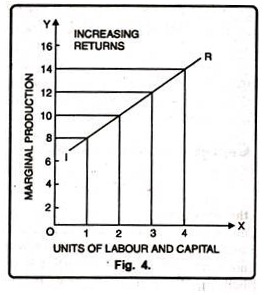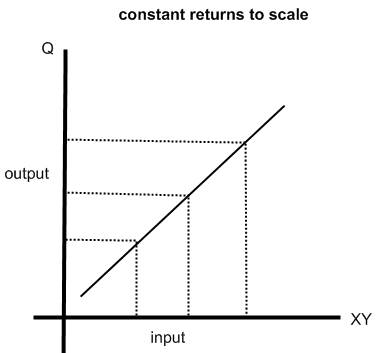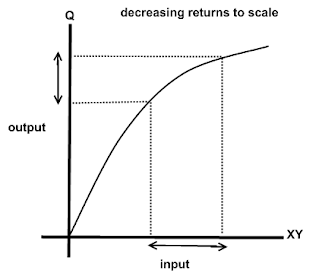LAW OF RETURNS TO SCALE
Returns to scale tells how production changes in response to an increase in all inputs in the long run. An industry can exhibit constant returns to scale, increasing returns to scale or decreasing returns to scale.
In the long- run, there is no fixed factor; all factors are variable. The laws of returns to scale explain the relationship between output and the scale of inputs in the long-run when all the inputs are increased in the same proportion.
ACCORDING TO KOUTSOYIANNIS
“The term returns to scale refers to the changes in output as all factors change by the same proportion.”
ACCORDING TO LEIBHAFSKY
“Returns to scale relates to the behaviour of total output as all inputs are varied and is a long run concept”.
ASSUMPTIONS OF LAW OF RETURNS TO SCALE
Laws of Returns to Scale are based on the following assumptions:
- All the factors of production (such as land, labour and capital) are variable but organization is fixed.
- There is no change in technology.
- There is perfect competition in the market.
- Outputs or returns are measured in physical quantities.
STAGES OF RETURNS TO SCALE
The various stages of law of return to scale can be shown from the following table:

LAW OF INCREASING RETURNS TO SCALE (IRS)
If the output of a firm increases more than in proportion to an equal percentage increase in all inputs, the production is said to exhibit increasing returns to scale.
ACCORDING TO MARSHALL
“An increase of labour and capital leads generally to improved organisation which increases the efficiency of the work of labour and capital. Therefore, an increase of labour and capital generally gives a return which increases more than in proportion.”
ACCORDING TO BENHAM
“As the proportion of one factor in a combination of factors is increased, upto a point, the marginal productivity of the factor will increase.”
ACCORDING TO MRS. JOAN ROBINSON
“Increasing Returns to a factor states that when an increasing amount of a factor of production is employed it generally brings about an improvement in organisation. As a result of it, units of the factor concerned become more efficient and to increase production it will not be necessary to increase the physical quantity of the factor in the same proportion.”
For example: If the amount of inputs are doubled and the output increases by more than double, it is said to be an increasing returns to scale. When there is an increase in the scale of production, it leads to lower average cost per unit produced as the firm enjoys economies of scale.
This can be explained with the help of following diagram:

In the figure, OX axis represents increase in labour and capital while OY axis shows marginal production. When labour and capital increases, output also increases which is higher than the factors of production i.e. labour and capital.
CAUSES OF INCREASING RETURNS TO SCALE
The following are the reasons of increasing returns to scale:
INDIVISIBILITY OF FACTORS OF PRODUCTION: There are some factors of production which are purchase in some fixed quantity and cannot be divided into small pieces; such factors of production are described as indivisible factors.
This indivisibility of factor of production is an advantage to the firm producing on a large scale.
By increasing production the cost of production goes on decreasing. Indivisibility is specially found in case of men and machines.
The machines have a minimum size whatever may be the level of out-put, the minimum size has to be employed. Naturally, with increasing output the cost of production will decline and the firm will reap the benefits of increasing return to scale.
- Marketing Indivisibilities: These relates to the employment of salesmen, maintenance of purchase, department and advertisement. The larger the scale of production less will be the per unit cost.
- Financial Indivisibilities: These relate to the managing costs of loans securities issued in large quantities can be listed in the stock exchange where-as the smaller quantities will increase the cost.
- Research Indivisibilities: The research and innovation department need some bare essential sum of money on men and material needed for research projects, less than that of research cannot be carried on. Thus, there are Critical minimum efforts needed to carry on the production job irrespective of the scale of production. With the increase in the scale of production the cost of production declines which give rise to the Laws of Increasing Return to scale.
SPECIALISATION OF FACTOR OF PRODUCTION: The second major reason for the operation of Law of Increasing Return to scale is the specialisation of the factor of production and division of labour. These results in greater production or increasing return to scale. The concept of division of labour and specialisation can be extended to the organization.
Each manager specialises in his work resulting in increasing return to scale. Apart from the above two major factors the other important constituents of Law of Increasing Return to scale is the economies of large scale production i.e., internal and external economies of scale.
DIMENSIONAL EFFICIENCY: Increasing returns to scale is the result of operating dimensional efficiency in a business firm which is on account of the large size. The size increases the efficiency of all inputs and the increasing returns operates. Thus the investment in capital assets after a point will increase the output due to increased dimension of efficiency.
ECONOMIES OF LARGE SCALE: When the scale of production is increased the internal and external economies of scale will operate and on account of it the increasing returns to scale will also operate.
Internal economies are on account of firm’s size and organisation while external economies are caused by the concentration and localisation of industries. All these economies lead to increase in output more than in proportion to the change in the ratio of two inputs.
LAW OF CONSTANT RETURNS
When all inputs are increased by a certain percentage, the output increases by the same percentage, the production function is said to exhibit constant returns to scale.
For example:
If a firm doubles inputs, it doubles output. In case, it triples output. The constant scale of production has no effect on average cost per unit produced.
This can be explained with the help of following diagram:

If the proportional increase in all inputs is equal to the proportional increase in output (production), returns to scale are constant. For instance, if a simultaneous doubling of all inputs results in a doubling of production, then returns to scale are constant. 100% increase in the inputs may raise the production level to 100%.
CAUSES OF CONSTANT RETURNS TO SCALE
The following are the various causes of returns to scale:
INTERNAL ECONOMIES AND DISECONOMIES: As the firm expands further, internal economies are counterbalanced by internal diseconomies. Returns increase in the same proportion so that there are constant returns to scale over a long range of output.
EXTERNAL ECONOMIES AND DISECONOMIES: The returns to scale are constant when external diseconomies and economies are neutralized and output increases in the same proportion.
DIVISIBLE FACTORS: When factors of production are perfectly divisible, substitutable and homogeneous with perfectly elastic supplies at a given price, returns to scale are constant.
LAW OF DECREASING RETURNS
Where the proportionate increase in the inputs does not lead to equivalent increase in output, the output increases at a decreasing rate, the law of decreasing returns to scale is said to operate. This results in higher average cost per unit.
ACCORDING TO BOULDING
“As we increase the quantity for any one input which is combined with fixed quantity of other inputs, the marginal physical productivity of the variable input must eventually decline.”
ACCORDING TO PROF. BENHAM
“As the proportion of one factor in a combination of factors is increased after a point, the marginal and average product of that factor will diminish.”

All factors of production (land, labor and capital) have been doubled. There is 100 percent increase in the factors of production whereas output has increased less than double.It means increase in all inputs leads to a less than proportional increase in the output of the firm. Here diminishing returns to scale are operating. Diminishing returns to scale is achieved in those activities involving natural resources such as growing agricultural products.
CAUSES OF DECREASING RETURNS TO SCALE
(I) DISECONOMIES OF LARGE SCALE: When the scale of production is increased the internal and external diseconomies of scale operate. On account of these diseconomies the output increases less than in proportion to the change in the inputs and the diminishing returns to scale operates.
(II) DELAY IN DECISION-MAKING AND ITS IMPLEMENTATION: With the size of scale of production the decisions are taken at different levels of management. Delay in decision-making and its implementation lead to increase in output less than in proportion to the change in all variable inputs. Pressure from top management, red-tapism and diseconomies of managerial skill lead to diminishing returns to scale.
(III) MANAGERIAL INEFFICIENCY: With the increase in the size and scale of production in the long period the management becomes a complicated process. It results into managerial inefficiency leading to operation of diminishing returns to scale.
(IV) INDUSTRIAL UNREST: With the increase in the size and scale of production the number of workers increases. There will be political affiliation of trade unions leading to strikes, lockouts, go slow tactics, gheraos, etc. These labour problems are not easily solved by the management. It adversely affects the production of individual firms or industries and diminishing returns to scale operates.
(V) ENTREPRENEUR NOT VARIABLE: Entrepreneur is one of the factors of production. He is neither variable nor divisible input. In practice he is fixed and indivisible input and on account of change in other variable inputs the ratio under the large scale leads to imbalances and the law of diminishing returns to scale operates.
(VI) OVER-EXPLOITATION OF SCARCE INPUTS: When the scale of production is increased and some of the scarce inputs are exploited to unlimited extent the increase in output is less in proportion to change in all inputs during long period and diminishing return to scale operates.